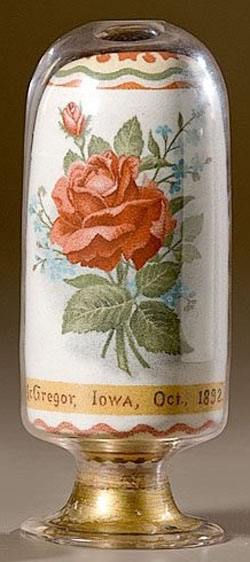Also see: A World in a Grain of Sand: Andrew Clemens’ Sand Bottles
It’s always exciting when research brings new things to light and because of a lecture given at the Midwest Antiques Forum, I’m able to revisit something I’ve written about before – the sand bottle art of Andrew Clemens (1857? to 1894) of McGregor, Iowa (originally covered in our May 2011 newsletter). Clemens, left deaf and mostly, it’s believed, mute by a bout of encephalitis as a young boy, made incredible works of art like the one here by positioning sand one grain at a time. Recent research into Clemens by Wes Cowan of Cowan’s Auctions (also star of PBS’s History Detectives and a frequent guest on Antiques Roadshow) has identified around 50 bottles (he believes he knows of at least another 50 or so), and this process has allowed us to see how the bottles changed over time.
One myth that the lecture dispelled was the belief that Clemens collected all the sand himself, that the colors were all naturally occurring in the Picture Rocks area near McGregor. Most of the sand was naturally occurring, but some colors, blues and greens, for instance, were so rare that it would have take far too long to collect them solely from a natural source. Closer examination reveals “filler” and artificial color, as well as the use of bits of charcoal for blacks and greys used in shading.
Perhaps, however, the most amazing discovery is some documentary evidence relating to the creation of the sand bottles. Cowan’s research has uncovered a printed price list, offering everything from flowers to eagles to steamboats, with prices ranging from 50 cents to around five dollars. This seems like such a small amount for such amazing, precise work, until placed in the context of one of the only known surviving letters from Clemens to a customer, discussing his process for the work and telling him that for a jar of the type requested, it normally took him just about two days….
-Hollie Davis, Senior Editor, p4A.com





1 comment
Comments feed for this article
Trackback link: https://www.prices4antiques.com/blog/andrew-clemens-sand-bottles-revisited/trackback/